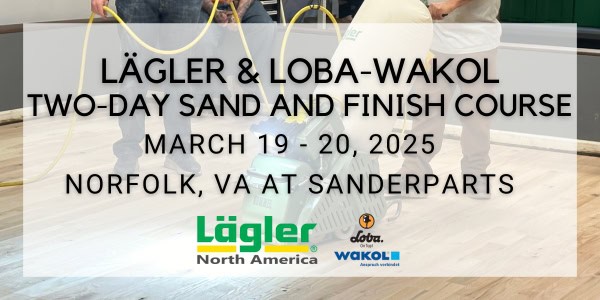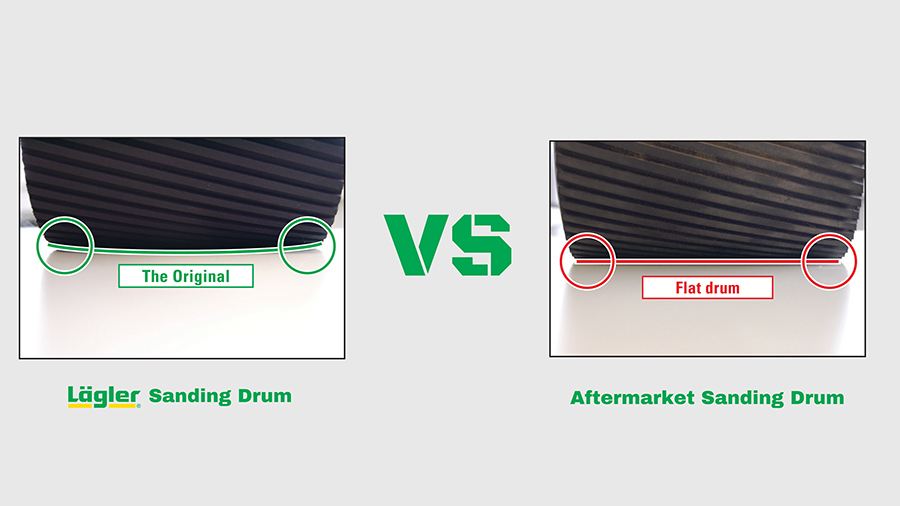
You are here:

There are a lot of parts to care about with a “big machine” like Lägler’s HUMMEL. But even if you keep it purring, clean and rolling smoothly, it won’t
do you any good if you use a sanding drum that mars the floor with edge marks, waves and chatter.
You can see where we’re headed here, right? We recommend the Lägler sanding drum, of course. But, like everything with Lägler, there is a reason behind
the design. There are reasons we recommend the Lägler drum, and only the Lägler drum.
It simply isn’t the apples-to-apples trade with aftermarket versions like you might think.
In this post, we explain why Lägler recommends not using aftermarket or recycled drums, and how you can know whether a drum you are buying is an authentic
Lägler drum.
The Importance of the Sanding Drum
The quality and condition of your sanding drum is crucial for sanding success. It transfers the machine’s performance to the sand paper, which then impacts
the floor.
If a drum – the aluminum core, weight and outer layers of rubber – is older than four years, visibly worn out or damaged, or the rubber has hardened, it
needs to be replaced. We can promise a drum past its quality of life will give you sanding results your clients will not appreciate.
The “Football” Shape of Lägler Sanding Drums
When looking at a new Lägler sanding drum, it is easy to miss seeing that the drum’s diameter is larger in the middle than it is at the edges. But this
shape is crucial to the quality of a sanded surface. It also is why you do not need to dress a Lägler drum.
Non-Lägler sanding drums have a flat shape, touching the floor from edge to edge of the drum. While overlapping sanding paths, a small change in elevation
occurs. That leads to a flat sanding drum leaving marks where its edges cut the floor.
Lägler removes this risk of edge-cuts with its drums by decreasing the drum’s diameter from the middle to the outside. That slightly oblong shape, kind
of like a football, is exactly what’s needed for feathering at the edges while sanding.
Lägler drums focus sanding pressure evenly in the center portion of the drum, assuming you have leveled your HUMMEL wheels (extremely easy to do; watch
our one-minute video). You will be able to see that by the wear pattern on the abrasive belt.
Known Problems with Aftermarket + Recycled Sanding Drums
The market offers aftermarket and recycled sanding drums that fit on the Lägler HUMMEL, but they are not equal replacements for a Lägler original drum.
They cause damage to floors.
That damage leads to call-backs and more expense on your part as the sanding professional to fix the issues with the floor and to replace the faulty drum
so it doesn’t continue to cause problems.
On occasion, Lägler receives warranty claims for drums, and they are rejected. Virtually all these claims are based on problems that come from using non-Lägler
drum.
Problems that occur with aftermarket and recycled drums are:
4 Visible Signs of Aftermarket Drums
Sanding drums that are not Lägler originals manufactured at Lägler headquarters in Germany have a few tell-tale signs. Here are four clear ways to see
that a sanding drum is an aftermarket drum.
Overlapping rubber layers. There are two layers of rubber on a drum. Aftermarket drums overlap, creating a hardened spot that will cause
vibrations that lead to waves. Lägler drums have rubber layers of even thickness, with the outer layer applied evenly on top of the inner layer, no
overlap.
No “football” shape. Adding to what’s been described in the section about football shape above, the larger contact area of non-Lägler
drums reduces aggression by up to 20 percent.
Worn out bore. Lägler does not reuse old sanding drums. The bore where the drum slides on and off the drum shaft gets worn out. To reuse
a drum, each bore would have to be replaced to be able to guarantee the refurbished drum is properly balanced. The cost of that effort makes recycled
drums too expensive.
Out of balance. Lägler uses special screws as balancing weights on the sanding drum core’s lid. Those weights are new for each drum. Lägler
has perfected its balancing act, keeping each end of the drum within less than 4/100 of an ounce. Sanding drums being recycled for resale need to be
re-balanced because of new rubber being applied, but drums that try to reuse old cores and old weights can’t be properly balanced.
The Bottom Line of Using Aftermarket Sanding Drum on You HUMMEL
The issues laid out above not only lead to poor sanding results, they cause more frequent sanding drum replacements. That costs you more money.
We’re sure you’ve heard, “You get what you pay for.” You probably have said that to a hesitant client or two over the years, too, when they are considering
hiring your competitor with a lower estimate, right?
Think about all we’ve said in this blog post, and it’s easy to understand the importance of a just-right drum to the livelihood of Lägler as a company.
Bad drums lead to bad experiences and bad sanding results with Lägler’s HUMMEL; that would lead to a loss of sanding pros’ confidence in Lägler in
142 countries worldwide. A big deal.
If you have questions about Lägler sanding drums, or anything else Lägler, comment below or call us at 800-8-HUMMEL (800-848-6635) during
weekday business hours.
Other ways to learn more are:

Lägler North America, a division of Palo Duro Hardwoods, is the North American distributor of machines and parts manufactured by Eugen Lägler GmbH in Germany. We are North America’s machine repair center, and offer Lägler’s one-day Premium Sanding Technology (PST®) certification course.
Copyright © 2020 Lägler North America. All Rights Reserved.